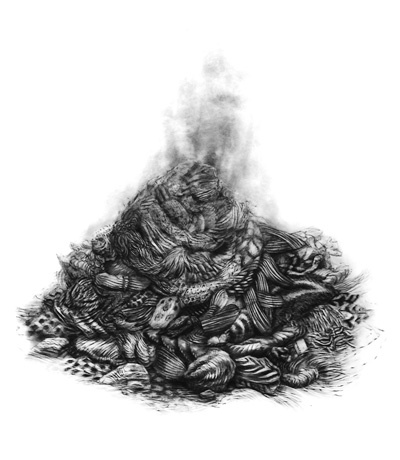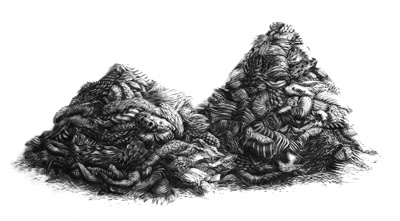Barbara Moody at Kingston Gallery
drawings about discarding and ritual renewal
By: Shawn Hill - Oct 19, 2007
Barbara MoodyRemains
October 2-27th, 2007
Kingston Gallery
Boston, MA
In Moody's new show of her latest large-scale charcoal drawings, the focus is on trash. Disheveled, lumpen piles of stuff dominate each composition, and they are quite impressive accumulations of debris. Moody's mastery of charcoal and conte crayons and chalk unites this work in pristine shades of black and gray and white. Her real agenda becomes clearer only when one tries to focus on the items that comprise these junkyard hills.
Because that focus just can't be achieved. A few thematic items are recognizable, but most are more like shapes, blurred and evocative, but generalized, not particular. You imagine windows, tires, old clothing and machinery in "Enough," but you can't really put your finger on any of those things.
In "Two Piles" one sees plant and vegetal forms, artichoke leaves, braided and knotted lengths of yarn, perhaps tangles of unraveled intestines and animal skins. But they become homogenous masses, ironically orderly for all their evocations of refuse. The boneless carcasses in "Stack" are piled so high they seem to lean against one edge of the paper, listing out of control. The delineation and shading is impeccable, and does seem to reveal cheetah pelts, pig snouts, maybe snakes and muskrats and hyenas, all part of this morass.
Other piles feature "hides" that look more like wool and leather, like old scarves and coats and shirts and boots that are being discarded, once loved but now unfashionable or worn out. From image to image, one starts to wonder, just where are these piles? Moody leaves the negative space completely white, voids into which these metaphorical bundles have been somehow deposited. There's no horizon, no interior or landscape cues.
Coupled with undefined, gestural nature of many of the textures and almost recognizable items, one realizes these piles could be any sort of debris, anything really that we have sorted through and realized we must discard. Rather than arrays of useless accumulation, Moody's images feel quite hopeful, dramatizing for us in black and white her own process of ritual cleansing and letting go.
Other clues are provided by a series of images that recall earlier work, featuring sheep and goats in various dilemmas. Moody zooms into loving close-ups on their dumb animal faces, making portraits of creatures caught in a "Tangle" of brambles, or "Embedded" in a lush bush of leaves. These poor critters may not know how to escape (or even really understand that they're trapped), but we're smart enough to figure it out.
The animal hides seem to refer to Moody's own earlier zoologically rich work, now being put away. An experimental work in vinyl wall appliqué, "Remains," reveals another source in collage, a variety of photographic snippets (of snake skin and armadillos and limbs and other textures) that somehow isn't as crisp or compelling as the lovely drawings. The smooth texture isn't as inviting as all that solid white paper.
Moody has a deft hand, elegant coordination that keeps these piles of debris compelling and full of individual character. A series of sixty much smaller drawings is even whimsical, with piles of stones, piles of bricks, piles that look like dollops of cream and others that look like cow pies. It's all ripe material, Moody seems to say, for creation and renewal.



